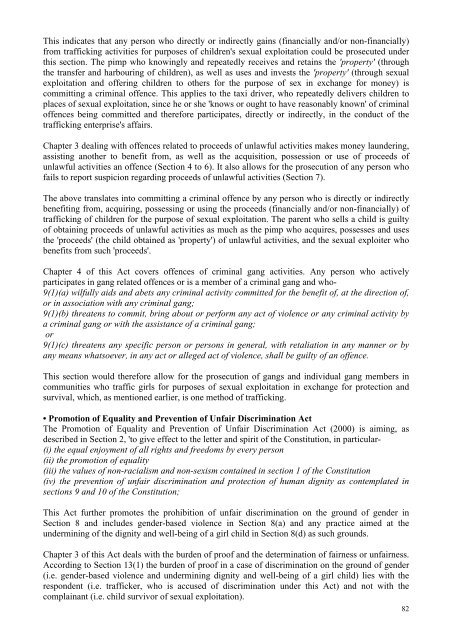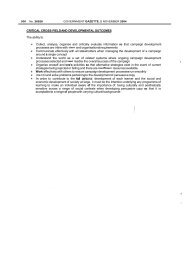The trafficking of children for purposes of sexual exploitation
The trafficking of children for purposes of sexual exploitation
The trafficking of children for purposes of sexual exploitation
You also want an ePaper? Increase the reach of your titles
YUMPU automatically turns print PDFs into web optimized ePapers that Google loves.
This indicates that any person who directly or indirectly gains (financially and/or non-financially)<br />
from <strong>trafficking</strong> activities <strong>for</strong> <strong>purposes</strong> <strong>of</strong> <strong>children</strong>'s <strong>sexual</strong> <strong>exploitation</strong> could be prosecuted under<br />
this section. <strong>The</strong> pimp who knowingly and repeatedly receives and retains the 'property' (through<br />
the transfer and harbouring <strong>of</strong> <strong>children</strong>), as well as uses and invests the 'property' (through <strong>sexual</strong><br />
<strong>exploitation</strong> and <strong>of</strong>fering <strong>children</strong> to others <strong>for</strong> the purpose <strong>of</strong> sex in exchange <strong>for</strong> money) is<br />
committing a criminal <strong>of</strong>fence. This applies to the taxi driver, who repeatedly delivers <strong>children</strong> to<br />
places <strong>of</strong> <strong>sexual</strong> <strong>exploitation</strong>, since he or she 'knows or ought to have reasonably known' <strong>of</strong> criminal<br />
<strong>of</strong>fences being committed and there<strong>for</strong>e participates, directly or indirectly, in the conduct <strong>of</strong> the<br />
<strong>trafficking</strong> enterprise's affairs.<br />
Chapter 3 dealing with <strong>of</strong>fences related to proceeds <strong>of</strong> unlawful activities makes money laundering,<br />
assisting another to benefit from, as well as the acquisition, possession or use <strong>of</strong> proceeds <strong>of</strong><br />
unlawful activities an <strong>of</strong>fence (Section 4 to 6). It also allows <strong>for</strong> the prosecution <strong>of</strong> any person who<br />
fails to report suspicion regarding proceeds <strong>of</strong> unlawful activities (Section 7).<br />
<strong>The</strong> above translates into committing a criminal <strong>of</strong>fence by any person who is directly or indirectly<br />
benefiting from, acquiring, possessing or using the proceeds (financially and/or non-financially) <strong>of</strong><br />
<strong>trafficking</strong> <strong>of</strong> <strong>children</strong> <strong>for</strong> the purpose <strong>of</strong> <strong>sexual</strong> <strong>exploitation</strong>. <strong>The</strong> parent who sells a child is guilty<br />
<strong>of</strong> obtaining proceeds <strong>of</strong> unlawful activities as much as the pimp who acquires, possesses and uses<br />
the 'proceeds' (the child obtained as 'property') <strong>of</strong> unlawful activities, and the <strong>sexual</strong> exploiter who<br />
benefits from such 'proceeds'.<br />
Chapter 4 <strong>of</strong> this Act covers <strong>of</strong>fences <strong>of</strong> criminal gang activities. Any person who actively<br />
participates in gang related <strong>of</strong>fences or is a member <strong>of</strong> a criminal gang and who-<br />
9(1)(a) wilfully aids and abets any criminal activity committed <strong>for</strong> the benefit <strong>of</strong>, at the direction <strong>of</strong>,<br />
or in association with any criminal gang;<br />
9(1)(b) threatens to commit, bring about or per<strong>for</strong>m any act <strong>of</strong> violence or any criminal activity by<br />
a criminal gang or with the assistance <strong>of</strong> a criminal gang;<br />
or<br />
9(1)(c) threatens any specific person or persons in general, with retaliation in any manner or by<br />
any means whatsoever, in any act or alleged act <strong>of</strong> violence, shall be guilty <strong>of</strong> an <strong>of</strong>fence.<br />
This section would there<strong>for</strong>e allow <strong>for</strong> the prosecution <strong>of</strong> gangs and individual gang members in<br />
communities who traffic girls <strong>for</strong> <strong>purposes</strong> <strong>of</strong> <strong>sexual</strong> <strong>exploitation</strong> in exchange <strong>for</strong> protection and<br />
survival, which, as mentioned earlier, is one method <strong>of</strong> <strong>trafficking</strong>.<br />
• Promotion <strong>of</strong> Equality and Prevention <strong>of</strong> Unfair Discrimination Act<br />
<strong>The</strong> Promotion <strong>of</strong> Equality and Prevention <strong>of</strong> Unfair Discrimination Act (2000) is aiming, as<br />
described in Section 2, 'to give effect to the letter and spirit <strong>of</strong> the Constitution, in particular-<br />
(i) the equal enjoyment <strong>of</strong> all rights and freedoms by every person<br />
(ii) the promotion <strong>of</strong> equality<br />
(iii) the values <strong>of</strong> non-racialism and non-sexism contained in section 1 <strong>of</strong> the Constitution<br />
(iv) the prevention <strong>of</strong> unfair discrimination and protection <strong>of</strong> human dignity as contemplated in<br />
sections 9 and 10 <strong>of</strong> the Constitution;<br />
This Act further promotes the prohibition <strong>of</strong> unfair discrimination on the ground <strong>of</strong> gender in<br />
Section 8 and includes gender-based violence in Section 8(a) and any practice aimed at the<br />
undermining <strong>of</strong> the dignity and well-being <strong>of</strong> a girl child in Section 8(d) as such grounds.<br />
Chapter 3 <strong>of</strong> this Act deals with the burden <strong>of</strong> pro<strong>of</strong> and the determination <strong>of</strong> fairness or unfairness.<br />
According to Section 13(1) the burden <strong>of</strong> pro<strong>of</strong> in a case <strong>of</strong> discrimination on the ground <strong>of</strong> gender<br />
(i.e. gender-based violence and undermining dignity and well-being <strong>of</strong> a girl child) lies with the<br />
respondent (i.e. trafficker, who is accused <strong>of</strong> discrimination under this Act) and not with the<br />
complainant (i.e. child survivor <strong>of</strong> <strong>sexual</strong> <strong>exploitation</strong>).<br />
82
















